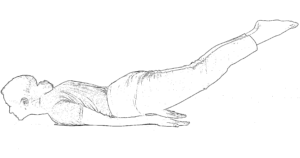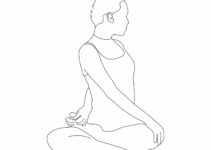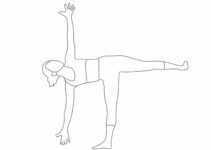What is a Salabhasana yoga?
- Salabhasana can be read as sha-la-BAHS-anna salabha = grasshopper, locust.
- Salabhasana is an excellent prone lying yoga pose and highly beneficial for the health and strength of the lower back.
- It is called the locust pose because the legs are raised in the final position to imitate the tail of a locust.
- Because of this fashion, it is also known as the grasshopper pose.
- The backward bending yoga pose plays an important role in the health of the pelvis, abdomen, and chest.
- It is one of the excellent yoga poses which gives a direct message to the heart.
- Both Salabhasana and Bhujangasana are complementary to each other.

Tips for beginners
For beginners, performing salabhasana is difficult. The beginners experience difficulty because of the contraction of the lower back muscles. In such conditions, one should perform Ardha shalabhasana first. Ardha shalabhasana is a comparatively more straightforward yoga pose and simultaneously makes your back muscles stronger to gain mastery over salabhasana.
How to do salabhasana?
- Lie flat on the ground in a prone fashion, face downwards.
- Legs should be straight with the feet together, and toes should be pointed upwards.
- The arms may be kept on either side of the legs or under the legs.
- The chin should be in contact with the ground throughout the practice.
- Relax the whole body.
- Inhale; raise both legs at your convenience while keeping them together and straight.
- Maintain the position as long as you can.
- Exhale, brings your legs down.
- Do 2-3 rounds.
Breathing and awareness
Breathing should be kept in mind while performing locust pose. While lying flat in the prone position, the practitioner should exhale profoundly and inhale deeply. Inhale, and could you raise your legs as it is convenient for you? Please keep your breath while holding the position. Exhale while bringing your legs down. Have a rest and do normal breathing.
Points to be remembered
- While performing the yoga pose, the shoulders should be as close as possible to the ground.
- The chin should be in contact with the ground throughout the practice.
- Legs should be straight and stretch both at the ground and at the raised position.
- Your toes and soles should be pointed outwards.
- The abdomen should sustain most of the body parts.
Precautions
There are some limitations and contradictions while performing the yoga pose. Under the following conditions, it should be avoided. If you want to perform, it is better to do the practice under the guidance of a yoga expert.
- High blood pressure
- Heart disease
- Asthma
- Hernia
- peptic ulcer
- Intestinal tuberculosis
- Back injury
- Mild sciatica
- Slipped disc
- Headache
- Pregnancy
Eight best benefits of Salabhasana
- Shalabhasana stimulates the autonomic nervous system, especially the parasympathetic one.
- The practice of the locust pose ensures the stretching of the nerves and improves blood circulation, thereby allowing new oxygenated blood to circulate.
- Since the parasympathetic nerves are widespread in the neck and pelvis regions, this yoga pose is quite effective for the health of these body parts.
- All the abdominal organs are suitably massaged, thus preventing the practitioners from many diseases and disorders.
- Practising the locust pose exerts adequate pressure in the abdominal region, which transmits to the vital organs such as the lungs and heart. Accordingly, it enhances the efficiency of these organs.
- The pose aids digestion and relieves gastric troubles and flatulence.
- The pose practice stretches the spine, benefiting the sacral and lumbar regions.
- The bladder and prostrate gland also benefited due to the practice of this yoga pose.
Muscular actions
- Erector spinae
- Gluteus maximus
- Hamstrings
- Soleus
- Deltoids
- Triceps
- Serratus anterior
Preparatory poses
- Tadasana
- Yastikasana
- Ardha Salabhasana
- Bhujangasana
Follow-Up poses
- Setubandhasana
- Pawanmuktasana
- Halasana
- Vipritkarni
- Ardha halasana
Therapeutic Applications
- Back pain
- Spinal Health
- Constipation
- Indigestion
- Sciatica
- Cardiac health
- Lungs efficiency
- Urinary disorder
- Reproductive system
What is ardha Shalabhasana?
It is also known as the half-locust pose. The practising of the half locust pose is much easier than salabhasana and gives almost the same benefits as that of the locust pose. Suppose somebody has experienced difficulty in performing Salabhasana; it is better to start with Ardha. As far as precautions, benefits, and breathing awareness are concerned, these are almost the same as salbhasana’s.
How to do ardha salabhasana?
More or less, the technique of performing Salabhasana is the same as that of Shalabhasana. Here, instead of raising two legs, only one is raised at a time. Here, one thing has to be remembered: the left leg should be raised first. This is necessary so that the abdominal pressure is applied firstly on the right side of the abdomen, which in turn pressurises and massages the ascending colon of the large intestine situated on the right side of the body. In this way, the large intestine is massaged in the same order as the action of intestinal peristalsis. This is a great help in removing constipation.

Origin of Salabhasana
Salabhasanan comes from a Sanskrit word that means locust or grasshopper. Though it has not been mentioned in the Hatha yoga text yet, it has been mentioned in Yoga and Kriya by Swami Satyananda Saraswati and Light on Yoga by B K S Iyengar.






thanx for sharing valuable article